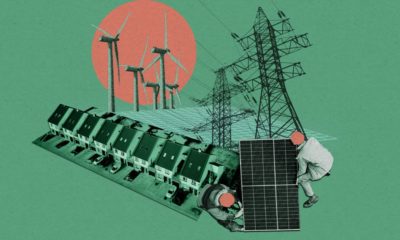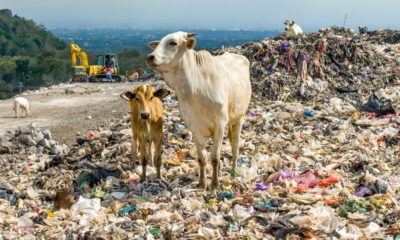Politics
14 Ways You Can Use Technology to Eliminate Environmental Pollution
Published
1 year agoon
By
Drew Simpson
Environmental pollution is the leading cause of global warming in the present day. The effects of environmental pollution are being felt worldwide. There have been prolonged extreme temperature levels during summer and winter, wildfires in Europe, Australia, and North America, changing seasons, prolonged drought and famine, and diseases from exposure to industrial waste and smoke.
The effects of environmental pollution are at an alarmingly uncontrollable level. However, technologists are using their knowledge to help reverse ecological pollution effects when the future looks gloomy.
This article discusses the different technologies used in various sectors to reduce or eliminate environmental pollution.
Ways Technology is Assisting in the Elimination of Environmental Pollution
Below are several ways people are using technology to eliminate environmental pollution;
-
Electric Cars to Mitigate Vehicle Emissions
Since the invention of cars, the use of fuels like petrol and diesel has built concern over the long-term effects. The internal combustion engines of petrol and diesel cars emit carbon dioxide (co2) as a by-product.
Greenhouse gases trap heat below the ozone layer, promoting high temperatures on earth. The gas also damages the ozone layer by cooling the stratosphere, slowing down the process of ozone loss, and increasing ozone levels.
The electric car does not use an internal combustion engine but a chargeable battery. This invention is estimated to reduce emissions by diesel vehicles by 43% and lower global warming temperatures by nearly 1.50C. The electric vehicle may not produce environmentally harmful emissions; however, the car uses electrically powered batteries that generate electric power mainly from fossil fuels. With this in mind, electric cars still cause environmental pollution.
-
Use of Geographic Information Systems (GIS) to Improve Water Quality
Water pollution is a worldwide concern as people and sea animals heavily feel its effects. Large bodies of water, such as oceans and seas, are impacted by uncontrolled chemical disposal by large companies.
Many manufacturing plants near bodies of water opt to dump untreated waste into these water bodies. As vessels transport fuel from port to port, there have also been increased maritime traffic and oil spillages. This, in turn, affects the blue economy of countries such as China, whose fish have been reduced by nearly half. Municipalities are also to blame, as township sewage is directed to water bodies.
The GIS system enables the collection and storage of spatial data for bodies of water, allowing experts to detect and manage changes in mineral and pH levels. The system will enable experts to create model sewage systems, groundwater, and nonpoint water pollution. This computer application is easy to access remotely as it is operated via satellite.
In the past, it would be unheard of to share an uber with a stranger. Still, lately, people are embracing it to save money, efficiently utilize the vehicle, and in the process, help reduce environmental pollution.
Owning a car in a busy city is not practical as it will lead to more traffic and carbon emissions. Many companies, such as Penske Corp, have embraced car sharing by making their cars available to clients at convenient locations throughout DC for rental through their Penske Dash app.
Companies have also cut electricity consumption and heat, reducing the production of fossil-fueled electricity. These small changes may prove very beneficial in time. They, however, face criticism because of increased demand for electricity and heat in homes, which counters the positive strides taken.
With the emergence of the Covid pandemic, many companies switched to working remotely. This made many people realize the power of working from home, saving the cost of fare and fuel. This resulted in less traffic and a reduction in carbon emissions.
However, we are not all lucky to work remotely, so if you still commute to work, you can ensure you are not contributing to environmental pollution by using an e-bike. Compared to regular bikes, e-bikes are faster, environmentally friendly, and ensure you are not delayed by traffic, thus arriving at work on time.
It was noted that during the pandemic, the rate of carbon emissions in the United States was significantly reduced after the government mandated people to stop their movements unless necessary.
-
Use of Fuel Cells and Single-Cycle Gas Turbines
To cleanly produce electricity, fuel cells and single-cycle gas turbines have been developed. These systems ensure efficiency in converting fuel to electricity, lowering greenhouse gas emissions. It has a separate anode and cathode, allowing carbon dioxide to separate from the system. The systems are highly reliable and durable and can integrate into landfill gas and digesters.
-
Remote Sensing Technology in Municipal Water Use.
Have you heard of water accounting? The phrase means that every drop of water in water projects should be accounted for. As a result of deforestation and prolonged periods of drought, this sensory system helps municipal governments use water more effectively with the current water insecurity.
The sensory technology is inexpensive as it is satellite operated, and its information is accessible via internet platforms such as Google. The data is constantly republished into the cloud and provides high-resolution images.
Combining these images and graphic representation sheets helps water resource experts understand water consumption and reporting, giving the areas water balance.
As a result of human activities, wildlife has had to adapt to the changing weather conditions, with some fauna ready to go extinct. Environmental scientists are, however, taking measures to save nearly extinct animals. For example, African wildlife services have implemented a GPS collar to track some of these animals. Such a system has assisted in mitigating poaching and promoting access to these animals when needed.
There have also been gene sequencing studies that help save endangered species from deadly diseases such as cancer. This sequencing has also prompted the development of a predictive analytic system that allows environmentalists to study different animal species and their adaptability.
There have also been sim-based collars that allow conservationists to trace animal whereabouts in human habitats, thereby reducing human-wildlife conflict.
-
Creation of the Artificial Trees
Deforestation is another environmental issue that governments have grappled with over the years. Many trees have been cut down to give way to urban and agricultural development. This has promoted the drying of water sources, lack of oxygen, and water erosion.
Technologists have engaged their scientific counterparts to develop the supertree, an artificial tree that aids oxygen production. The tree uses water filtration to take in at least 200,000 cm3 of polluted air and give out clean, breathable oxygen. Although expensive, this tree has had excellent results in places such as Peru and Lima. One supertree may set a municipal back by at least 100,000 sterling.
-
Online Data Storage to Reduce Paper Waste
The demand for paper in past years saw industries cut down many trees to satisfy the demand. It promoted negative repercussions such as soil erosion and the extinction of rivers.
With paperless technology, however, demand for paper has effectively reduced. There has also been a decreasing demand for hard cash as countries embrace digital currency with apps such as PayPal and use credit and debit cards as the most common means of transaction. Such strides have not only reduced deforestation but have also reduced the emission of greenhouse gases.
-
Use of Solar Power as a Renewable Energy
Solar energy is a cheap and safer alternative to fossil fuels or hydroelectric energy. Many households are using this technology to cut costs on electricity bills, with some having transitioned entirely to solar power.
The solar panel comprises photovoltaic cells that can convert sunlight energy to direct current in order to power bulbs and charge electric devices. This type of energy is considered one of the most renewable resources.
-
The International Methane Remote Observatory
This research technique is used to help understand the origin of methane, a greenhouse gas responsible for much of global warming. This research institute is funded by the UNEP and obtains data from satellites, past scientific studies, and ground-based sensors. The observatory funds research studies on methane and has also involved petroleum companies in research projects.
-
Use of Genetically Engineered Organisms for Waste Management
In the past, the human population only relied on natural microorganisms to break down waste. These organisms cannot treat industrial waste, sewage, or oil spills. Genetically engineered organisms have been modified to break down what seemed to be non-decomposable. It includes industrial waste, petroleum spills, and fungicides.
Genetically engineered organisms (GEOs), also known as bio-remediation, are gaining ground in many industries in the United States to assist in waste management as it is relatively cost-effective due to the lack of post-cleanup costs. The technology, however, faces skepticism as it has not been used before and may have unforeseen risks.
-
Use of Aerial Photography to Monitor Environmental Compliance
Aerial photography is an excellent way to see and interpret data in any landscape study. Aerial surveys provide evidence based on photographs. The images can be taken at any time and provide a way to keep dishonest industries accountable.
-
Development of Tiny Homes
The idea behind tiny homes is to minimize energy consumption and keep the production of waste at a minimum. The people living in these tiny houses adopt a minimalist lifestyle. Most tend to lean toward an eco-friendly lifestyle, thus reducing pollution.
This involves using solar panels, fewer building materials, compostable toilets, and energy-saving appliances.
Final Thoughts
Technology in environmental conservation is a magical platform filled with endless opportunities. To reach the full potential of this sector, technologists need significant funding that enables research.
The international methane observatory, for example, has made massive strides in mitigation against methane production with the financial backup of UNEP. The use of technology, even in minor ways, such as transiting to solar panels, makes a massive difference for the environment.
What technological change have you made to reduce environmental pollution?
Featured Image Credit: Provided by the Author; Pexels; Thank you!
You may like
-


How carbon removal technology is like a time machine
-


Four ways AI is making the power grid faster and more resilient
-


How to make government technology better
-


Plastic is a climate change problem. There are ways to fix it.
-


Top Strategies of Lead Generation for Technology Companies
-


15 Proven Ways to Increase Customer Engagement and Build Loyalty
Politics
Fintech Kennek raises $12.5M seed round to digitize lending
Published
7 months agoon
10/11/2023By
Drew Simpson
London-based fintech startup Kennek has raised $12.5 million in seed funding to expand its lending operating system.
According to an Oct. 10 tech.eu report, the round was led by HV Capital and included participation from Dutch Founders Fund, AlbionVC, FFVC, Plug & Play Ventures, and Syndicate One. Kennek offers software-as-a-service tools to help non-bank lenders streamline their operations using open banking, open finance, and payments.
The platform aims to automate time-consuming manual tasks and consolidate fragmented data to simplify lending. Xavier De Pauw, founder of Kennek said:
“Until kennek, lenders had to devote countless hours to menial operational tasks and deal with jumbled and hard-coded data – which makes every other part of lending a headache. As former lenders ourselves, we lived and breathed these frustrations, and built kennek to make them a thing of the past.”
The company said the latest funding round was oversubscribed and closed quickly despite the challenging fundraising environment. The new capital will be used to expand Kennek’s engineering team and strengthen its market position in the UK while exploring expansion into other European markets. Barbod Namini, Partner at lead investor HV Capital, commented on the investment:
“Kennek has developed an ambitious and genuinely unique proposition which we think can be the foundation of the entire alternative lending space. […] It is a complicated market and a solution that brings together all information and stakeholders onto a single platform is highly compelling for both lenders & the ecosystem as a whole.”
The fintech lending space has grown rapidly in recent years, but many lenders still rely on legacy systems and manual processes that limit efficiency and scalability. Kennek aims to leverage open banking and data integration to provide lenders with a more streamlined, automated lending experience.
The seed funding will allow the London-based startup to continue developing its platform and expanding its team to meet demand from non-bank lenders looking to digitize operations. Kennek’s focus on the UK and Europe also comes amid rising adoption of open banking and open finance in the regions.
Featured Image Credit: Photo from Kennek.io; Thank you!
Radek Zielinski
Radek Zielinski is an experienced technology and financial journalist with a passion for cybersecurity and futurology.
Politics
Fortune 500’s race for generative AI breakthroughs
Published
7 months agoon
10/11/2023By
Drew Simpson
As excitement around generative AI grows, Fortune 500 companies, including Goldman Sachs, are carefully examining the possible applications of this technology. A recent survey of U.S. executives indicated that 60% believe generative AI will substantially impact their businesses in the long term. However, they anticipate a one to two-year timeframe before implementing their initial solutions. This optimism stems from the potential of generative AI to revolutionize various aspects of businesses, from enhancing customer experiences to optimizing internal processes. In the short term, companies will likely focus on pilot projects and experimentation, gradually integrating generative AI into their operations as they witness its positive influence on efficiency and profitability.
Goldman Sachs’ Cautious Approach to Implementing Generative AI
In a recent interview, Goldman Sachs CIO Marco Argenti revealed that the firm has not yet implemented any generative AI use cases. Instead, the company focuses on experimentation and setting high standards before adopting the technology. Argenti recognized the desire for outcomes in areas like developer and operational efficiency but emphasized ensuring precision before putting experimental AI use cases into production.
According to Argenti, striking the right balance between driving innovation and maintaining accuracy is crucial for successfully integrating generative AI within the firm. Goldman Sachs intends to continue exploring this emerging technology’s potential benefits and applications while diligently assessing risks to ensure it meets the company’s stringent quality standards.
One possible application for Goldman Sachs is in software development, where the company has observed a 20-40% productivity increase during its trials. The goal is for 1,000 developers to utilize generative AI tools by year’s end. However, Argenti emphasized that a well-defined expectation of return on investment is necessary before fully integrating generative AI into production.
To achieve this, the company plans to implement a systematic and strategic approach to adopting generative AI, ensuring that it complements and enhances the skills of its developers. Additionally, Goldman Sachs intends to evaluate the long-term impact of generative AI on their software development processes and the overall quality of the applications being developed.
Goldman Sachs’ approach to AI implementation goes beyond merely executing models. The firm has created a platform encompassing technical, legal, and compliance assessments to filter out improper content and keep track of all interactions. This comprehensive system ensures seamless integration of artificial intelligence in operations while adhering to regulatory standards and maintaining client confidentiality. Moreover, the platform continuously improves and adapts its algorithms, allowing Goldman Sachs to stay at the forefront of technology and offer its clients the most efficient and secure services.
Featured Image Credit: Photo by Google DeepMind; Pexels; Thank you!
Deanna Ritchie
Managing Editor at ReadWrite
Deanna is the Managing Editor at ReadWrite. Previously she worked as the Editor in Chief for Startup Grind and has over 20+ years of experience in content management and content development.
Politics
UK seizes web3 opportunity simplifying crypto regulations
Published
7 months agoon
10/10/2023By
Drew Simpson
As Web3 companies increasingly consider leaving the United States due to regulatory ambiguity, the United Kingdom must simplify its cryptocurrency regulations to attract these businesses. The conservative think tank Policy Exchange recently released a report detailing ten suggestions for improving Web3 regulation in the country. Among the recommendations are reducing liability for token holders in decentralized autonomous organizations (DAOs) and encouraging the Financial Conduct Authority (FCA) to adopt alternative Know Your Customer (KYC) methodologies, such as digital identities and blockchain analytics tools. These suggestions aim to position the UK as a hub for Web3 innovation and attract blockchain-based businesses looking for a more conducive regulatory environment.
Streamlining Cryptocurrency Regulations for Innovation
To make it easier for emerging Web3 companies to navigate existing legal frameworks and contribute to the UK’s digital economy growth, the government must streamline cryptocurrency regulations and adopt forward-looking approaches. By making the regulatory landscape clear and straightforward, the UK can create an environment that fosters innovation, growth, and competitiveness in the global fintech industry.
The Policy Exchange report also recommends not weakening self-hosted wallets or treating proof-of-stake (PoS) services as financial services. This approach aims to protect the fundamental principles of decentralization and user autonomy while strongly emphasizing security and regulatory compliance. By doing so, the UK can nurture an environment that encourages innovation and the continued growth of blockchain technology.
Despite recent strict measures by UK authorities, such as His Majesty’s Treasury and the FCA, toward the digital assets sector, the proposed changes in the Policy Exchange report strive to make the UK a more attractive location for Web3 enterprises. By adopting these suggestions, the UK can demonstrate its commitment to fostering innovation in the rapidly evolving blockchain and cryptocurrency industries while ensuring a robust and transparent regulatory environment.
The ongoing uncertainty surrounding cryptocurrency regulations in various countries has prompted Web3 companies to explore alternative jurisdictions with more precise legal frameworks. As the United States grapples with regulatory ambiguity, the United Kingdom can position itself as a hub for Web3 innovation by simplifying and streamlining its cryptocurrency regulations.
Featured Image Credit: Photo by Jonathan Borba; Pexels; Thank you!
Deanna Ritchie
Managing Editor at ReadWrite
Deanna is the Managing Editor at ReadWrite. Previously she worked as the Editor in Chief for Startup Grind and has over 20+ years of experience in content management and content development.
